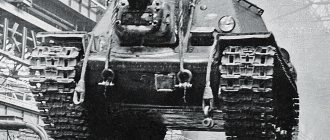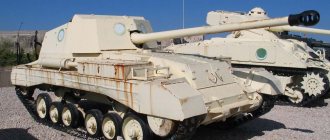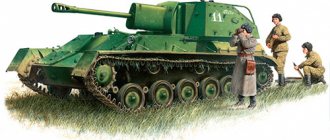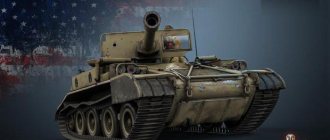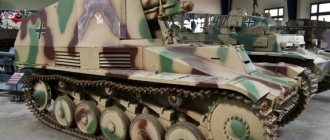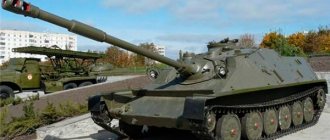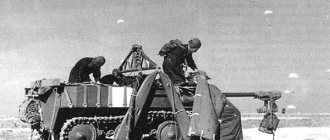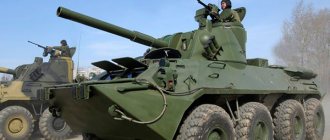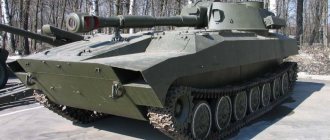Self-propelled gun SU-152 “St. John’s wort” – self-propelled artillery mount 152 mm caliber
The development of a larger tank destroyer, armed with the 152 mm ML-20 gun, was a direct response to the appearance of the Tiger tank by the Germans during the battles near besieged Leningrad in January 1943. Throughout 1942, two teams of designers from the Central Design Bureau (TsKB-2), led by veteran Lieutenant Colonel Kotin (he was responsible for the development of the KV tank), worked on the creation of a new heavy tank designed to replace the aging KV-1.
Self-propelled gun SU-152 “St. John's wort” – video
By the end of 1943, the new vehicle, developed by Kotin's team, was to become the basis for the KV-85 tank and a series of heavy IS tanks, which were to fight until the end of the war. At the beginning of 1943, the projects were still far from complete. Neither the State Defense Committee nor the command of the Red Army, who saw an urgent need for vehicles capable of fighting the Tigers, could put up with this state of affairs. Just 25 days after receiving the order to begin work, Kotin and L. Troyanov completed the creation of projects for two self-propelled guns - tank destroyers.
The KV-12 was equipped with a 203 mm B-4 howitzer of the 1931 model. Due to the fact that the gun was inferior in range to the 88-mm Tiger cannon, the project was rejected. On the contrary, the KV-14 project, created on the KV-1 chassis and equipped with a long-range 152-mm ML-20 howitzer, was put into service on February 14, 1943 under the name SU-152. The initial speed of the SU-152 projectile was 655 m/sec, which allowed it to penetrate 110 mm thick armor at a distance of 2000 m. The effectiveness of the gun was low due to the need to use separately loaded ammunition. This reduced the rate of fire to two rounds per minute. Like most Soviet tanks and self-propelled guns, the actual ability to hit targets at the range specified in the technical specifications was limited by the poor quality of the telescopic sights. However, it should be noted that as soon as new heavy tanks began to arrive in the army, the main task of the SU-152 was to provide fire support to the infantry.
The first regiment, armed with the SU-152, was formed in May 1943 and, like units equipped with the SU-76i, was sent to the Kursk salient. There were only 12 vehicles available, but as was later announced, they destroyed 12 Tigers and 7 Elephants (a self-propelled assault gun that also made its debut during the Battle of Kursk). These statements cannot be confirmed, since throughout the war, tankers and artillerymen of both sides tended to report that when any enemy tank was defeated, it was the most powerful in the enemy’s arsenal. What is clear is that the SU-152 proved to be extremely effective, earning the nickname "St. John's Wort" for its successful fight against the German "zoo" - Tigers, Panthers and Elephants.
Tactical and technical characteristics of the self-propelled gun SU-152 “St. John’s wort”
| Crew, people | 5 |
| Combat weight, t | 45,5 |
| Length, m | 8,95 |
| Width, m | 3,25 |
| Height, m | 2,45 |
| Ground clearance, mm | 440 |
| Armament | 152 mm howitzer-gun ML-20 |
| Engine | V-2K, diesel, 600 hp. |
| Maximum speed, km/h | 43 |
| Cruising range over rough terrain, km | 165 |
| Cruising range on the highway, km | 330 |
| Reservation, mm | Hull front 60 mm Headhouse 75 mm Hull side 60 mm Stern 60 mm Roof 20-30 mm Bottom 20-30 mm |
Photo of SU-152 “St. John's wort”
Destroyed Soviet self-propelled gun SU-152 August 1943
Source
Howitzer on a heavy tank chassis
This howitzer was already installed on the chassis of the KV tank, although it was done differently. During the war with Finland, siege weapons with a rotating turret KV-2 found combat use. These samples had a number of disadvantages, in particular, a very high profile, which unmasked the equipment and made it easier for enemy weapons to hit it. In order to reduce the weight and height of the self-propelled gun and simplify its production technology, in 1943 tank engineers from Chelyabinsk decided to install the gun in a fixed wheelhouse. In December of the same year, development work was completed, and ChKZ began mass production.
There is nothing surprising in the name of the installation. SU-152 stands for this: a self-propelled gun with a 152 mm caliber gun.
The first self-propelled guns “St. John’s worts” ISU-152
The OF-540 high-explosive fragmentation grenade weighing 43.56 kg upon exiting the ISU-152 barrel had a speed of 655 m/s and, when the fuse was set to fragmentation action, caused damage with fragments 40 m along the front and 8 m in depth. The BR-540 armor-piercing tracer projectile, when exiting the barrel with an initial speed of 600 m/s, pierced the frontal armor of all Wehrmacht tanks at a distance of up to 1500 m. When it hit the tower, it tore it off the shoulder strap. Due to its very large mass of 48.8 kg (for comparison: an 85-mm armor-piercing projectile had a mass of 9.2 kg), even if it did not penetrate a heavily armored target (for example, the Ferdinand assault gun), it was guaranteed to disable it due to breakdowns of components and mechanisms due to shock and damage to the crew due to numerous internal spalls of the armor. Firing enemy vehicles with high-explosive and concrete-piercing shells produced good results. When using the G-530 concrete-piercing projectile for its intended purpose, it pierced a reinforced concrete wall about 1 m thick. However, on the Kursk Bulge, the new self-propelled guns did not have to destroy long-term enemy firing points, but they fired a lot at German tanks, and quite successfully. Thus, Major Sankovsky, using his ISU-152, knocked out 10 tanks in one day. On July 8, 1943, the ISU-152 regiment fired at the attacking Ferdinands of the 653rd division, knocking out four enemy vehicles. It was then that soldiers began to call heavy artillery self-propelled guns “St. John’s worts.”
Self-propelled gun ISU-152 in the courtyard of the Chelyabinsk Kirov plant. Spring 1944
The main "beast"
In order to objectively assess the chances of our self-propelled gun in an artillery duel with the Tiger, it is necessary to compare the capabilities of these vehicles in such a situation.
So, the first thing you should pay attention to is the range of aimed fire. It is approximately the same for these two samples, but it should be noted that the quality of German optics is higher than ours, although Soviet sights cannot be called bad.
The second important factor is the rate of fire. Our self-propelled guns could fire only two shots in a minute; the heavy weight of the projectile (up to 60 kg) and the tightness in the control room were a hindrance. The Germans could have fired six times during the same time.
The subject of the third comparison is caliber. This is exactly what led to the unofficial name of the SU-152 self-propelled gun. Here the superiority of our self-propelled guns over the enemy “beast” is undeniable. Where are 88 millimeters compared to our 152s! The trouble was that the German caliber was quite enough to penetrate the six-centimeter armor of a Soviet self-propelled gun. And the Germans had much more shells in their ammunition load - 90 against our twenty. And yet, the Tiger’s turret was rotated by an electric motor, while the ML-20 had a rotation angle of only 12 degrees in each direction.
Notes[edit]
- Green, Michael; Brown, James D. (2008), "Red Army Solutions for the Tiger E Tank", Tiger Tanks at War
, St. Paul: Zenith Press, p. 104, ISBN 978-0-7603-3112-5 - Vollert, Jochen (2004). Tankograd Militar Fahrzeug - Special No.
2001 Soviet Special - KV-2 Soviet heavy breakthrough tank from the Great Patriotic War . Publishing house Tankograd. paragraph 29. - Zaloga 1984: 165
- "Archival copy". Archived from the original on 2012-07-10. Retrieved 24 October 2011.CS1 maint: archived copy as title (link)
- Combat history of Schwere Panzer Abteilung 654, Karlheinz Munch, pp.67-69
People win
Taking into account all the characteristics, we can conclude that our self-propelled gun was practically doomed in a collision with the Tiger, but this is not so. Each time, the outcome of the duel was influenced by many factors, including the training of the crews, the presence of combat experience, knowledge of the terrain, and simply courage. It was important to take the best position, to detect the enemy as early as possible, to shoot first, and, most importantly, to hit. And often our tank artillerymen managed all this better than the Germans. And then they could praise their car: “St. John's wort!” (as the Red Army soldiers called the SU-152 self-propelled gun).
What was the combat vehicle armed with?
The 152-mm ML-20S gun-howitzer, which was previously used as a towed version (model 1937), was used as the main tank gun.
To mount the gun on the tank, a frame mounted on the armor plate of the frontal part was used. Unlike the towed version, howitzers on the ISU-152 are installed so that the flywheels that provide vertical and horizontal guidance are not located on both sides of the gun, but are moved to the left side. This design solution ensured comfortable work for the crew. In the ISU-152, vertical aiming ranged from -3 to +20 degrees, horizontal - 10. Firing was carried out at a height of 180 cm. Firing was carried out using electric or manual mechanical triggers.
In 1945, weapons designers decided to equip the tank with a DShK 12.7 mm large-caliber anti-aircraft machine gun. It could have an open or K-8T anti-aircraft sight and was designed to fire 250 rounds. The mounting location for the machine gun was the turret on the right commander's hatch.
In addition to the tank cannon and machine gun, the crew was armed with two PPSh or PPS machine guns for self-defense. Their ammunition consisted of 1491 rounds of ammunition, which were contained in twenty discs. The crew also had 20 F-1 hand grenades at their disposal.
Construction and design[edit]
152 mm howitzer-gun ML-20S for SU-152 in the Motovilikha Plants Museum, Russia)
The SU-152 followed the same fully enclosed casemate design as most other Soviet self-propelled guns. The fully armored hull was divided into two compartments: the fighting compartment for the crew, gun and ammunition in the front of the hull, and the engine and transmission separate in the rear. The hull was welded from rolled armor plates of different thicknesses - 75, 60, 30 and 20 mm. The armor plates of the front hull and superstructure were sloped to better protect the vehicle; the side armor was vertical. The lower part of the front part of the hull and the rear armor plates were cylindrical and were quite complex in the manufacturing method. The ML-20S howitzer gun was mounted slightly to the right of center with limited guidance in the range of 12 degrees. To the left of the gun were three crew members: in front was the driver, then the gunner and the last loader. On the right were the vehicle commander and the bolt operator.
The suspension consisted of twelve torsion bars with six road wheels (each with a diameter of 600 mm) on each side. The drive sprockets were at the rear. Each track consisted of 90 stamped links with a width of 608 mm. The normal distance between two connected links was 160 mm. There were three internal fuel tanks, two in the crew area and one in the engine compartment, with a total capacity of 600–615 liters. These were usually supplemented by four unlinked external fuel tanks, which held an additional 360 liters of fuel. The 24-volt electrical power came from a 1 kW GT-4563A generator with an ACP-24 voltage regulator relay unit and four 6STE-128 battery packs with a total capacity of 256 amp-hours. This electrical equipment was common on many modern Soviet armored fighting vehicles. All other electrical equipment was powered from the generator and batteries - the ST-700 electric starter, radio receiver, intercom, external and internal lighting, and illumination of the sight scales.
For viewing from the inside, all roof hatches had periscopes and two sights: telescopic ST-10 (ST-10) and panoramic. For crew communication, a TPU-4-BisF intercom was installed, and for communication between vehicles, a single radio modem was installed. The first series of SU-152 was equipped with radio stations 9Р, then 10Р and, finally, 10РК-26. These radios were better than Soviet equipment at the beginning of the war, but remained inferior to German equipment.
The crew was armed with two PPSh machine guns and 25 F1 grenades for close combat self-defense.
